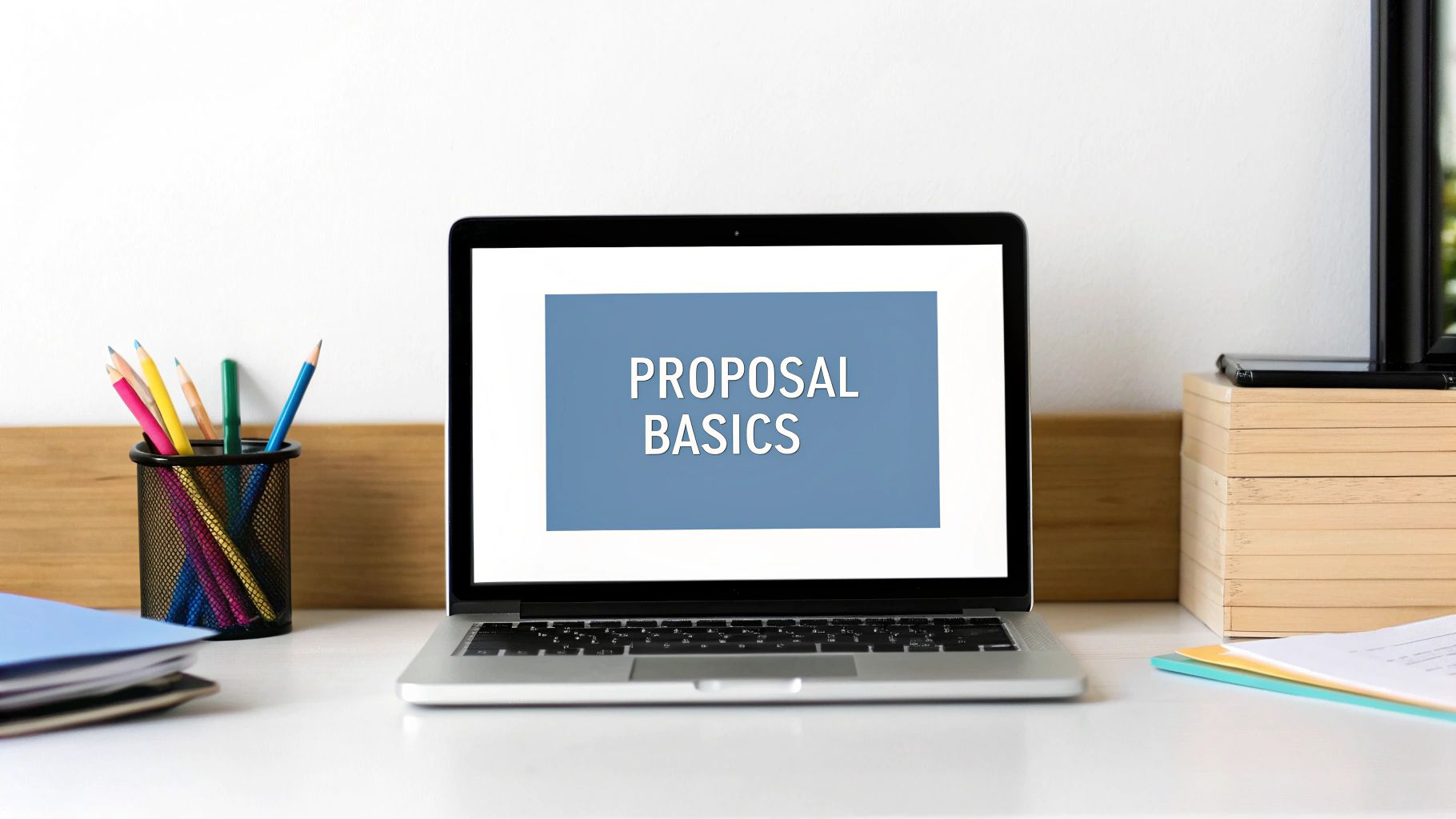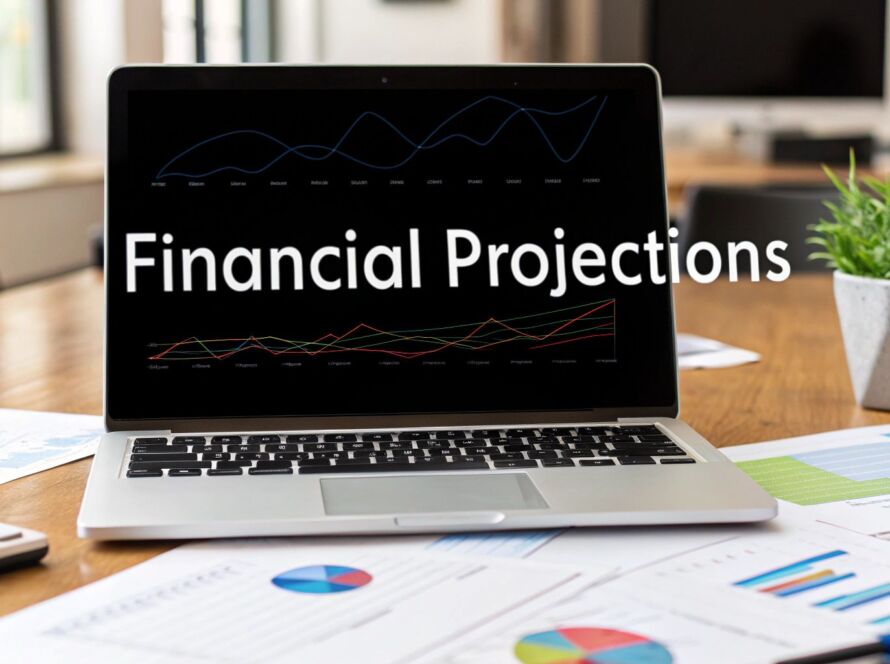Building the Foundation of a Winning Business Proposal
A business proposal is your gateway to new partnerships and opportunities. More than just paperwork, it's the key to showing clients exactly how you'll solve their problems and deliver real value. The way you craft your proposal can make all the difference between winning exciting new business and missing out on great opportunities.
Essential Elements of a Winning Proposal
Every successful proposal needs certain core elements working together to tell your story. Just like building a house needs a strong foundation, your proposal needs these key building blocks to stand out:
- Introduction: Make a strong first impression by clearly stating your proposal's purpose and briefly showcasing your company's expertise
- Problem Statement: Show you truly understand the client's challenges and pain points through detailed research
- Proposed Solution: Present your specific solution and focus on concrete benefits, not just features
- Implementation Plan: Map out clear timelines, resources needed, and major milestones
- Pricing and Value: Be upfront about costs while emphasizing the return on investment
- Team and Qualifications: Put faces to names by introducing the expert team who will deliver results
- Testimonials and Social Proof: Share real success stories from happy clients to build trust
- Call to Action: Make the next steps crystal clear and easy to take
Structuring Your Proposal for Maximum Impact
A well-organized proposal helps decision-makers quickly grasp your value proposition. Research of 1,026,891 business proposals shows that the ideal format includes six pages with eight key sections – from introduction through next steps. Following this proven structure can boost closing rates by 72%. Learn more tips at Proposify.
Engaging Your Audience
Keep your reader's attention by using clear, simple language and avoiding technical jargon. Break up text with visuals like charts and images to make key points stand out. The example below shows how professional design can make your proposal more engaging and memorable. Consider weaving in customer stories to show the real impact of your solutions.

When you follow these core principles, your business proposal becomes more than just a document – it becomes a powerful tool for growing your business and building lasting client relationships. Taking time to craft each element thoughtfully shows clients you're serious about delivering exceptional results.
Mastering Strategic Timing and Submission Psychology
Making a successful business proposal is all about perfect timing. Like a baseball player who knows exactly when to swing, your proposal's success depends heavily on when and how you deliver it. The key is understanding how decision-makers think and act throughout the entire proposal journey.

The Importance of Promptness
Quick action makes a big difference when submitting proposals. The numbers tell a compelling story – sending a proposal within 24 hours leads to a 25.9% success rate, with deals closing in about 6 days. Wait just 48 hours, though, and that rate drops to 7.6% with signing times stretching to 10 days. When you respond quickly, you show clients you value their time and business, setting a positive tone from the start. For more details on these findings, check out Process Street's research on business proposals.
Managing the Proposal Lifecycle
Success requires more than just quick submission – you need to guide your proposal through its entire journey thoughtfully. Here's how to keep things moving:
- Read the Signs: Watch how clients respond to your proposal. Their questions and level of interest give you clues about their decision timeline.
- Know Their Process: Ask about their review steps upfront. This helps you plan better and avoid awkward silences.
- Stay Connected: Keep in touch regularly, but don't overwhelm them. Brief check-ins show you care while giving them space to decide.
Optimal Positioning for Consideration
The final piece is presenting your proposal in a way that fits perfectly with how your client works. Focus on these key areas:
- Match Their Style: Some clients want short updates, others need detailed discussions. Adapt to what works for them.
- Smart Follow-up: Plan your check-ins carefully. Be available but not pushy.
- Build Real Connections: Use the proposal process to develop genuine relationships. This sets you apart and builds trust.
When you master these timing elements and truly understand how decisions get made, your proposals become much more effective. Think of each proposal as a chance to start a strong business relationship, not just close a deal.
Transforming Proposal Creation Through Modern Technology
Remember the days of spending hours writing, formatting, and revising business proposals? The process used to be incredibly time-consuming and labor-intensive. But there's good news – modern tools have changed the game completely. Now teams can focus on what really matters: telling compelling stories and building strong client relationships.
Streamlining Proposal Development With Software
The latest software solutions make proposal writing faster and more effective than ever before. Here are the key features that save time and boost quality:
- Template Management: Start with proven templates that maintain your brand look while eliminating formatting hassles
- Content Libraries: Quickly assemble personalized proposals using pre-written sections for company intros, services, and pricing
- Collaboration Tools: Work together seamlessly with real-time editing, comments, and approvals in one place
Picture this: A new client requests a proposal. Instead of starting from scratch, you select a template, add relevant pre-written content, and collaborate with your team to refine it – all in one platform. The result? A polished proposal in a fraction of the time.
Choosing the Right Technology Stack
Building an effective proposal technology system is crucial for growing your proposal output. When evaluating software options, focus on:
- Ease of Use: Look for intuitive interfaces that your team can learn quickly
- Integration Options: Ensure the tools work with your existing CRM and project systems
- Room to Grow: Choose solutions that can handle higher volume as your business expands
The numbers show the impact: From 2014 to 2019, businesses saw a 70% reduction in proposal creation time thanks to better collaboration, templates, and reusable content. Many now have dedicated proposal managers to oversee the process. See the full statistics here.
Balancing Technology With Human Expertise
While technology makes proposal creation more efficient, human insight remains essential. The tools help streamline the process, but crafting compelling messages and building client relationships still requires skilled professionals. The key is using technology to enhance your team's capabilities, not replace their expertise.
Analyzing Success Metrics and Competitive Positioning

Creating a powerful business proposal requires deep insight into what drives success in your market. Smart companies go beyond basic tracking to uncover meaningful patterns that help them stand out. By examining industry data and understanding how top performers position themselves, you can craft proposals that truly resonate.
Understanding Industry Benchmarks
How does your proposal success rate compare to others in your field? Having this context helps set realistic targets. Research shows the average proposal win rate across industries is 43%. The numbers tell an interesting story – enterprise companies achieve 46% wins versus 42% for smaller firms. For more details, check out Loopio's RFP Statistics. This data gives you a clear picture of where you stand and highlights opportunities to boost your success rate.
Conducting Competitive Analysis
Getting to know your competition is essential for standing out. Take time to study their proposals, marketing materials, and overall messaging. Look for gaps you can fill and ways to showcase what makes your solution special. For instance, you might emphasize specialized expertise, superior service, or unique capabilities that your competitors lack.
Leveraging Your Unique Strengths
The most successful proposals highlight what makes your company exceptional. Maybe you've developed special methodologies, built an impressive track record, or pioneered innovative approaches. Share concrete examples through case studies and client success stories. This shows prospects not just what you offer, but why you're the ideal choice for their needs.
Addressing Buyer Concerns Proactively
Smart companies anticipate and address concerns before they become roadblocks. Put yourself in your prospect's shoes – what might make them hesitate? Then directly address those points through flexible options, guarantees, or detailed risk management plans. This builds trust and shows you truly understand their perspective. When you combine these elements thoughtfully, your proposals will stand out even in crowded markets.
Creating Compelling Value Propositions That Resonate
A strong value proposition forms the core of every winning business proposal. It's not just about showing what your product can do – it's about telling a story that speaks to decision-makers' minds and hearts. Your proposal needs to clearly show how your solution tackles their specific challenges and goals. Think about it this way – a feature describes what your product does, while a benefit shows what your client gains. Take project management software – rather than just listing "task dependency tracking," highlight how it "cuts project delays and helps teams work more efficiently."
Frameworks for Articulating Value
You can use proven methods to structure your value proposition effectively. The Value Proposition Canvas helps match your product's capabilities to what customers truly need. Another helpful approach is the Problem-Solution-Benefit framework – clearly define the issue, present how you solve it, and spotlight the positive outcomes for the client. These frameworks keep your message focused on the client's perspective, making it more compelling and persuasive.
Presenting Pricing and ROI
The way you present pricing shapes how clients see your value. Instead of just stating costs, show pricing in terms of the concrete value delivered. Demonstrate the return on investment (ROI) clients can expect. For example, if your solution drives a 15% increase in sales, emphasize this measurable result rather than focusing solely on the price tag. Using hard data helps justify the investment and positions your solution as a valuable business asset.
Handling Objections and Positioning Premium Offerings
Get ahead of common concerns by addressing them directly in your proposal. If clients see your offering as costly, highlight the long-term savings or revenue gains it enables. For premium offerings, focus on their unique advantages – whether that's exclusive features, dedicated support, or guaranteed results. Make clear what sets these premium options apart and show how their added benefits justify the higher price point. This helps you promote high-end solutions while putting potential concerns to rest.
Creating Urgency Without Pressure
Build momentum without using aggressive sales tactics. You can highlight time-limited offers or special bonuses to encourage quick decisions. But avoid fake scarcity or pressure tactics. Instead, help clients understand the real costs of waiting too long – like missed revenue or falling behind competitors. This subtly motivates action while keeping interactions positive and respectful – essential for building lasting business relationships. Remember, your proposal sets the foundation for future partnerships. When you craft a value proposition that truly connects with your audience, you boost your chances of winning the deal and starting a successful long-term collaboration.
Securing the Deal: Strategic Follow-Up and Closure Techniques

A strong business proposal sets the foundation, but what happens next is just as crucial. The time between when you submit your proposal and when the client makes their decision is your chance to shine. Let's explore proven strategies to maintain momentum and close deals with confidence, while building genuine relationships along the way.
Effective Follow-Up Sequences
The key to following up successfully is finding the right balance. You want to stay on your prospect's radar without overwhelming them. Here's a proven approach that works:
- Initial Check-In: Send a brief, friendly email 2-3 business days after submitting your proposal to confirm they received it and offer to clarify any points.
- Add Real Value: About a week later, share something helpful like relevant case studies or research that speaks to their needs.
- Address Specific Questions: If they voiced concerns during your presentation, suggest a quick call to discuss solutions.
- Be Flexible: Show willingness to adjust terms or create custom options that better fit their situation.
- Final Touchpoint: If you haven't heard back within your expected timeline, send one last note restating key benefits and expressing continued interest in partnering together.
Working Through the Review Process
Remember that multiple people often need to sign off on proposals, each with their own priorities and concerns. Take time to understand what matters most to each stakeholder. When objections come up, see them as opportunities to demonstrate your expertise and commitment to finding the right solution.
Building Natural Momentum Toward Close
Instead of using pressure tactics, focus on showing clear value and benefits tied to timely action. For example, you might highlight how implementing sooner could help them meet important business goals. Stay positive and professional throughout – rushing decisions rarely leads to great long-term partnerships.
Are you ready to transform your business vision into a tangible reality? MarkBox Studios specializes in helping founders and business owners just like you. We focus on developing MVPs (Minimum Viable Products) and creating scalable solutions tailored to your specific needs. From weekly startup insights to personalized consultations, we empower you to achieve your business goals effectively. Connect with us today at MarkBox Studios and let's build something amazing together.



